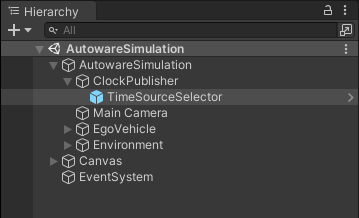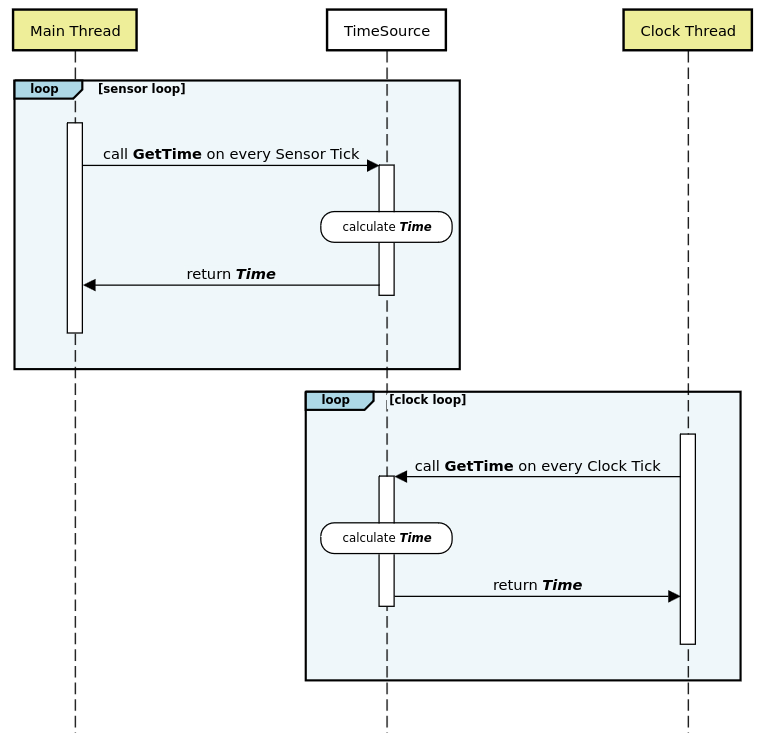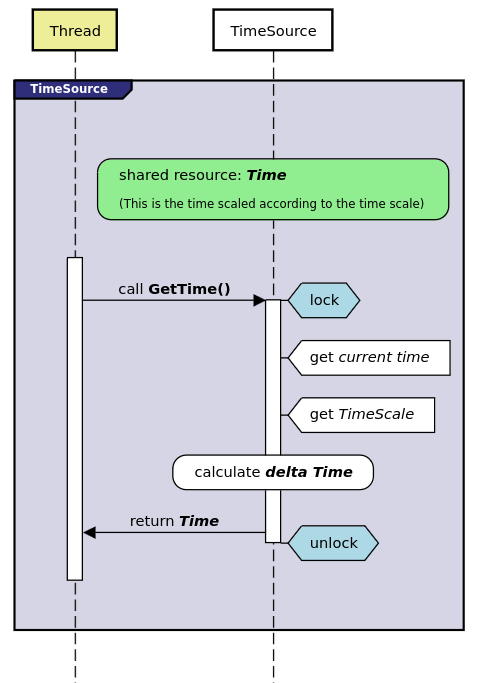Clock Publisher
Introduction
ClockPublisher allows the publication of the simulation time from the clock operating within AWSIM. The current time is retrived from a TimeSource object via the SimulatorROS2Node. The AWSIM provides convenient method for selecting the appropriate time source type as well as the flexibility to implement custom TimeSources tailored to specific user requirements.
Setup
To enable the publication of the current time during simulation execution, ClockPublisher must be included as a component within the scene. Moreover, to allow the TimeSource to be set or changed, the TimeSourceSelector object must also be present in the active scene.

Selecting Time Source
The desired TimeSource can be selected in two ways:
- Inspector Selection:
TimeSourcetype can be conveniently choosen directly from the editor interface.

- JSON Configuration File: Alternatively, the
TimeSourcetype can be specified in the JSON configuration file via the TimeSource field. The supported values for this field can be found in the list of available time sources in the "String Value for JSON Config" column.

List of Time Sources
| Type | String Value for JSON Config | Driven by | Start Value | Affected by Time Scale | Remarks |
|---|---|---|---|---|---|
| UNITY | unity | UnityEngine.Time | 0 | yes | |
| SS2 | ss2 | externally | depends on external source | no | used by the scenario simulator v2 |
| DOTNET_SYSTEM | system | System.DateTime | UNIX epoch | yes | starts with UNIX epoch time and progresses with System.DateTime scaled by AWSIM time scale |
| DOTNET_SIMULATION | simulation | System.DateTime | 0 | yes | starts with zero value and progresses with System.DateTime scaled by AWSIM time scale |
| ROS2 | ros2 | ROS2.Clock | UNIX epoch (by default) | no | uses ROS 2 time |
Architecture
The ClockPublisher operates within a dedicated thread called the 'Clock' thread. This design choice offers significant advantages by freeing the publishing process from the constraints imposed by fixed update limits. As a result, ClockPublisher is able to consistently publish time at a high rate, ensuring stability and accuracy.
Accessing Time Source
Running the clock publisher in a dedicated thread introduced the challenge of accessing shared resources by different threads. In our case, the Main Thread and Clock Thread compete for TimeSoruce resources. The diagram below illustrates this concurrent behaviour, with two distinct threads vying for access to the TimeSource:
- Main Thread: included publishing message by sensors (on the diagram blueish region labeled sensor loop),
- Clock Thread: included clock publisher (on the diagram blueish region labeled clock loop).
Given multiple sensors, each with its own publishing frequency, alongside a clock running at 100Hz, there is a notable competition for TimeSource resources. In such cases, it becomes imperative for the TimeSource class to be thread-safe.

Thread-Safe Time Source
The TimeSource synchronization mechanism employs a mutex to lock the necessary resource for the current thread. The sequence of actions undertaken each time the GetTime() method is called involves:
- acquiring the lock,
- getting the current time, e.g. system time since epoch, (this may be different for each type of time source),
- obtaining the current simulation time-scale,
- calculating the delta time since previous call, influenced by the time scale,
- returning the current time,
- releasing the lock.

Extensions
There are two additional classes used to synchronise the UnityEngine TimeAsDouble and TimeScale values between threads:
TimeScaleProvider: facilitates the synchronisation of the simulation time scale value across threads,TimeAsDoubleProvider: provides access to the UnityEngineTimeAsDoubleto the threads other than the main thread.